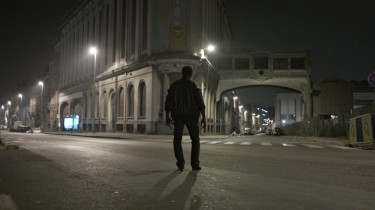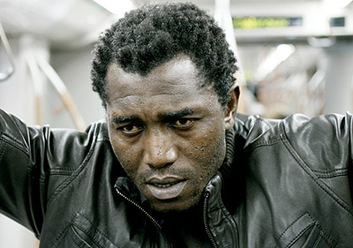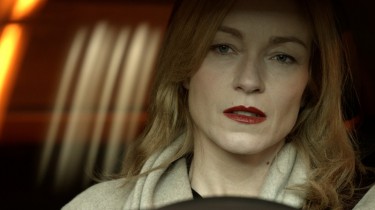 Back to selection
Back to selection
An Interview With The Invader Director Nicholas Provost

A sort of Taxi Driver set within the world of European immigrant culture, Nicolas Provost’s The Invader is one of the most intriguing and seductive films currently on the festival circuit. It premiered in Venice before screening in Toronto (where the below interview was conducted) and now Rotterdam, and it marks the feature debut of Provost (pictured above), a Belgian video and installation artist whose work has always taken as its subject the way cinema orders images into narrative.
The story opens with the camera fixed on the vagina of a beautiful blonde woman, sunbathing nude on a Southern European beach. It pulls back, taking in the scene of vacation frolickers until we spy Amadou (Issaka Sawadogo), an immigrant from Africa literally washing up on shore. After a hallucinatory sequence that sends Amadou from the beach to the city (Brussells), the film proper begins. Amadou is now part of an illegal labor force contracted out for day labor jobs by an imperious mid-level crime boss. An altercation with the boss sends Amadou on the street, without a job, money or papers. Spying a beautiful blonde executive, played by the stunning Stefania Rocca, he uses his considerable charm, verbal dexterity and sexual persuasiveness to insinuate himself into her life. Soon, though, his own anxieties, his resentments and feelings of being out of place, send him on a path to self-destruction.
Provocative in its socio, sexual and racial politics, The Invader makes us watch as an initially honorable African man gradually implodes when the shiny images of Western culture are dangled before him. The film plays with our sympathies, and our stereotypes, and it does so with a sleekly absorbing visual style. In the below interview, I talk with Provost about his art background, his move to feature filmmaking, and the archetypes he evokes in this picture.
 Filmmaker: Let me start with the obvious question: where did the idea of making this film come from?
Filmmaker: Let me start with the obvious question: where did the idea of making this film come from?
Provost: Well, as a visual artist working with the phenomenon of cinema, the grammar of cinema, [making a feature] was bound to happen. Everything I do is like sculpting with image and sound. [My work] looks very cinematic because it’s not abstract video art. It’s sometimes very narrative and since I play with film grammar in my video work, making a feature film was almost the same challenge. It was just longer, but you still ask yourself the same questions. How do you surprise an audience today when they’ve seen so much after 120 years of cinema? Like with all my work, I started from a few images, very intuitively, first having the feeling of what I wanted to convey, what feeling I wanted to [evoke in] the audience, and only then came the story. In 2004 I had made a short film with Issaka, the main actor, as a goodbye to a chapter of my life when I lived 10 years in Norway. It was such a good experience to work with him that I decided if I would ever make a feature, I’ll make it with him. I wanted a story that had a universal theme because I want to move the world, not just my country. Immigration politics, that’s something actual in Europe and all over the world. I think cinema has to be universal. It was a challenge, then for me to do something different, not only with my cinematic poetry but also with how I attacked that subject. So I put the immigration politics on the far background and told a story of an anti-hero because these are still my absolute favorite film journeys — the outsider stories, fighting the world around him and his own demons, becoming a hero, anti-hero. That’s what moves me the most in cinema.
Filmmaker: The film has an interesting structure in that the bulk of the middle is fairly realistic, but it’s bookended by these two very ambiguous sequences. I wasn’t sure whether they were meant to be reality, fantasy, or perhaps commentary on the film itself.
 Provost: Of course the opening scene, it had to be a commercial for Europe, for the modern New World that he’s looking for, his dream. The painting from Courbet, The Origin of the World, on which the first image of the film is based, I thought it was perfect to start the film from there. His journey, or the story of the film, is born out of the woman that he is looking for. That’s his goal — to become happy, to find emotional satisfaction — and the woman is fantastically played by Hannelore Knuts, who is a fashion icon and a very famous top model. Instead of using a Flemish actress or an extra, I thought it was important to use a symbol representing modern woman in emancipated Europe. The tunnel sequence that follows is a continuation of the beach scene. It’s his journey from the beach to the city. It’s his psychological downward spin towards hell. I wanted to create a feeling where this story is not just an anti-hero story. It’s also about our projection on immigrants. It becomes the monster that we project on immigrants, sometimes. I’m not trying to judge anyone. That’s what I hope is clear with the film, that I’m not taking parts. I’m not trying to come up with a voice for the immigrants, and I’m not blaming the Western world. It’s a tragic situation.
Provost: Of course the opening scene, it had to be a commercial for Europe, for the modern New World that he’s looking for, his dream. The painting from Courbet, The Origin of the World, on which the first image of the film is based, I thought it was perfect to start the film from there. His journey, or the story of the film, is born out of the woman that he is looking for. That’s his goal — to become happy, to find emotional satisfaction — and the woman is fantastically played by Hannelore Knuts, who is a fashion icon and a very famous top model. Instead of using a Flemish actress or an extra, I thought it was important to use a symbol representing modern woman in emancipated Europe. The tunnel sequence that follows is a continuation of the beach scene. It’s his journey from the beach to the city. It’s his psychological downward spin towards hell. I wanted to create a feeling where this story is not just an anti-hero story. It’s also about our projection on immigrants. It becomes the monster that we project on immigrants, sometimes. I’m not trying to judge anyone. That’s what I hope is clear with the film, that I’m not taking parts. I’m not trying to come up with a voice for the immigrants, and I’m not blaming the Western world. It’s a tragic situation.
Filmmaker: Do you work with a conventional screenplay?
Provost: I’m a terrible screenwriter (laughs). It takes me a lot of time. I had two good co-writers. We knew the film had to be very simple. I didn’t want it to be a plot-based film. It was a character-driven film. Again, I think it’s interesting to play with the expectation of the audience because I think they’re smarter than we think after 120 years of collective film memory. I like to flirt with different [expectations], to create expectations and then go on a different way. I think it’s interesting that [the film] suddenly turns into a thriller. The film opens like a dream and it could easily be read as pretentious. It’s then my challenge to not fall in that trap. That’s why I [followed it with] almost social realism before slowly going other places.
Filmmaker: The fixation on the blonde Western woman is something that the protagonist doesn’t seem to challenge. It’s like he, or even the film, accepts that he is almost powerless to resist her. There were maybe other things he could have done in the movie but he’s fixated on her.
Provost: Well, for me as a heterosexual man, the woman is still the mystery of life. It’s something I would have done, I think. I think it’s very touching that the first plot point is him putting all his hope on a woman. His friend just died, he has nothing, he has nowhere to sleep, so meeting this beautiful and powerful sexual presence….
Filmmaker: Are your shorts and work in the art world as narrative as this film is?
Provost: Well all the films that I make are between one minute and half an hour, and I use the language of cinema. The works that are closest to this feature film are my “Plot Point” trilogy. That’s three films: the first one is in New York, the second one is in Las Vegas and the third one is in Tokyo, which I’m making now. They’re 15 to 20 minute films where I’m filming in the street with a hidden camera, filming people who become characters. I imagine a story and in the editing process, I make fiction. It looks like pure fiction, not documentary. It’s not arty. It almost looks like a Michael Mann film. It’s a lot of work. The New York one plays with the police force as a character, New York as a character and suspicious looking characters in the streets. It plays with Hollywood thriller codes. The second part is in Las Vegas, which is called Stardust. There I play with crime film codes. I even got to film Dennis Hopper, probably the last appearance he ever made. Jack Nicholson, Jon Voigt . . . they appear in the film. Some of them I have directed, which was perfect for that concept of trying to make fiction with reality. And now the Tokyo film that I’m making, I’m following an actor who interacts with the real world, but it’s all hidden camera. People are not aware that he’s a fictional character, a serial killer, so it’s very exciting. It’s a very strange tension because you almost think it’s real but it’s not possible.
Filmmaker: Are these films shown in galleries, and on European TV?
Provost: All the platforms of the audio-visual that are there. They are broadcast on television but also sold in limited editions in galleries and museums.
Filmmaker: When you were making this feature, how much did you think of the filmgoing audience as opposed to your normal art world audience?
Provost: A lot (Laughs). Yes, because you try to reach as many people as possible. To go for a big audience you have to be very ambitious at the beginning. In all my work I’m afraid to bore an audience for one second. I try to make sure when the film starts the tension occurs from the beginning and works to the end. With a feature, it’s the same thing. With [The Invader] I chose to have a very simple story with not too much plot but with a very strong narrative structure so that I could smuggle a lot of my poetry in there.
Filmmaker: When you say your “poetry,” are you referring to the way you’ve captured the city and its textures, or the way you access the inner world of your protagonist?
Provost: That was a question from the audience yesterday. I had no idea how to answer that. How can you explain how you make that poetry? It’s with a huge love for cinema. I’m raised with film history. We’ve watched so many films in my family that today I have to give something back because cinema made me dream so much. Our common film memory, that’s something that I work with. We’ve all been subconsciously raised with the same cinema, with the same language, all over the world. I think an audience today understands much more than we think. I think it’s so beautiful to play with that collective memory we are all part of, and that maybe we have the same dreams because we’ve been watching the same material.
Filmmaker: How do you think that collective memory is changing today? Obviously younger audiences aren’t seeing all the films you grew up with. And the grammar is changing too.
Provost: I’m not sure that the grammar is changing. I have a feeling that it’s still the same thing. I still watch a lot of old films. For me anyway, the inspiration doesn’t come from cinema today. It’s very seldom that I’m moved today by a new product. Of course scripts become tighter and they try to re-invent it . . . it’s a lot of “trying to be smart.” I have a feeling that it used to be purer, earlier. I saw Shame yesterday, and I was very moved by it. It’s been a long time since I’ve seen something that was to me so inspiring. The poetry of [Steve McQueen’s] film language is so strong, so pure, and it has, funnily enough, several similarities to my film. From Venice, already they were telling me that we had almost exactly the same sex scene [with the woman pressed against the window]. The locations are very similar, and I was very afraid to be disappointed [by the film] but I was just blown away.
Filmmaker: Like you, Steve McQueen is an artist who has crossed over from visual art to feature filmmaking. Who do you consider your colleagues?
Provost: You mean in the visual arts or in the cinema?
Filmmaker: Either one.
Provost: My colleagues, my role models, the people who brought me the most are Hitchcock, Lynch and Kubrick. To me they are the most important masters. They made me dream the most. They made films that are like dreams, and I think that’s what a film should be. Of course there are some recent works: James Grey, it’s just unpretentious classicism. Love it. I thought Elephant from Gus Van Sant made a difference at a time. It was one of these key moments, like when Blue Velvet changed cinema in ’87, I think. And honestly when I saw Shame yesterday, I thought this is one of these moments that I’m experiencing like when I saw Blue Velvet or Elephant.
Filmmaker: Anything else you want to say or add about your film?
Provost: The most important thing is that people understand that it’s not a political film. It’s a subject that has always been there: immigration. For me, it’s important to do something completely different with it.
 Filmmaker: At the same time, I think it’s hard not to think of it as a political film because there’s a big dialogue about immigration politics in both Europe and the U.S. right now. And the politics of your film are provocative. You have an African protagonist who pretty much unquestioningly accepts and is corrupted by the Western ideal of a blonde, beautiful, sexualized woman. Faced with her presence, he loses control. Do you think he is a victim in the film?
Filmmaker: At the same time, I think it’s hard not to think of it as a political film because there’s a big dialogue about immigration politics in both Europe and the U.S. right now. And the politics of your film are provocative. You have an African protagonist who pretty much unquestioningly accepts and is corrupted by the Western ideal of a blonde, beautiful, sexualized woman. Faced with her presence, he loses control. Do you think he is a victim in the film?
Provost: No. That’s what I hope you don’t read. If there are victims in the film, we’re all victims, including, also, the woman. I hope it’s balanced, victim/hero, and that I’m not judging.
Filmmaker: Do you see the woman as a kind of iconic, essential ideal of beauty? Or is she a construct of Western media, of the ideals of advertising?
Provost: Both. It is an image that has been created but I love it. You’re attracted to it. It’s made to be attracted to. That’s what I think is fascinating. That’s what I hope you read through the film. The characters are very stereotypical, archetypal, but I hope that you can read on these archetypes different subtexts.
Filmmaker: Who’s the actress?
Provost: Stefania Rocca. She’s a very well respected star in Italy, and she has also played in several Abel Ferrara films. I discovered her in a French film, where she was playing a tormented character, the wife of a politician, and she played it in this very tormented tradition of Monica Vitti. It turned out that Monica Vitti was her mentor. She was a dream to work with. We just met in Venice last year on the film festival. We had 15 minutes to talk because she was presenting a film she made with Willem Dafoe directed by Defoe’s wife. And she said, “Well, I like your script, and it will be fine. We’ll be friends and you can ask me anything you want.” And that was it. I thought that was a good lesson for me, to always work with great actors who are professional, well prepared, who have done their homework, and who are not afraid of trust.
(Photo: Scott Macaulay)
